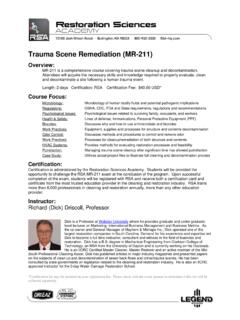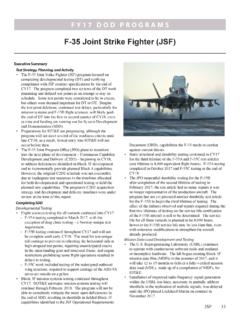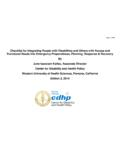Transcription of Content and Abstracts - Euromed Communications
1 VOLUME 14 NUMBER 1 2009 Contents Editorial: It s all about risk 3 Biological indicators don t lie, but in sporicidal gassing disinfection cycles do they sometimes confuse the truth? James Drinkwater, John Chewins, Graham Steele 5 The nature and the environmental impact of control of floor-level contamination Gerry Prout 13 Comparing flow rates of microporous membranes Maik W Jornitz, Theodore H Meltzer 19 GMP origins to today: some personal reflections John Sharp 24 Regulatory review Stephen Fairchild 31 Letter to the editor 32 Dates for your diary 33 Index to Volume 13 34 Instructions for authors in this issue Content and Abstracts Biological indicators don t lie, but in sporicidal gassing disinfection cycles do they sometimes confuse the truth?
2 James Drinkwater1, John Chewins2, Graham Steele3 1 Process Director, Bioquell UK, Vice Chairman, Pharmaceutical and Healthcare sciences Society; 2 Microbiologist, Bioquell UK; 3 Consultant Microbiologist, Albert Browne Ltd (Steris Corporation) It is important to acknowledge the possible presence of in-lot , out-of-trend, highly resistant rogue biological indicators (BIs) in sporicidal gassing cycle qualification. Potential false-positive rogue results require management strategies.
3 Equally, it is important to recognise when resultant BI positives are due to process lethality failure and not the BIs. Geobacillus stearothermophilus BIs are used in both steam sterilisation and hydrogen peroxide vapour disinfection cycle qualifications. The characteristics of BIs change to challenge the different processes of sterilisation and disinfection. Information on BIs in the European1 and United States Pharmacopoeia2 relates primarily to BIs for sterilisation processes and the requirements do not fully translate for BIs used in disinfection sporicidal gassing cycles.
4 As there are no specific references in standards or the Pharmacopoeias to sporicidal gassing as a surface disinfection process, a Parenteral Drug Association (PDA) task force is developing a technical report on Biological Indicators for Sporicidal Vapor Phase Decontamination Processes: Specification, Manufacture, Control and Use . This report will also make reference to hydrogen peroxide vapour as a surface disinfection process. The presentation of the spore inocula has a significant impact on efficacy of the disinfection process to inactivate spores at a high level of reduction.
5 Steam sterilisation, incorporating air removal and steam under pressure, has penetrative capability, hence spore clumps can be inactivated. In contrast, atmospheric applications with hydrogen peroxide vapour and other gaseous agents can be limited in penetrative capability, hence the main purpose of the process is surface disinfection/decontamination. This paper explains the science of the most commonly employed vapour phase disinfection process using hydrogen peroxide, and describes requirements for BIs to challenge the process.
6 Strategies for managing unexpected BI positive growth as a result of rogue BIs are put forward. Key words: Rogue biological indicators, hydrogen peroxide vapour decontamination *Corresponding author: James Drinkwater, Process Director, Bioquell UK Ltd, 52 Royce Close, West Portway, Andover, Hampshire SP10 3TS, UK. Email: The nature and the environmental impact of control of floor level contamination Gerry Prout Kennet Bioservices Ltd, Swindon, Wiltshire, UK The nature of particulate contamination in the operation of cleanrooms is reviewed; particulate of greatest significance and most numerous is less than 10 microns and emanates primarily from movement of personnel.
7 Significant contamination at floor level results from carryover of foot- and wheel-borne particulate and is normally controlled by the use of peel-off adhesive mats or, increasingly, by polymeric contamination-control flooring. Previously reported research on control of contamination is briefly reviewed to illustrate the distribution of particle sizes at floor level and the efficiency with which they are collected by peel-off mats and by proprietary contamination-control flooring. Polymeric flooring is shown to demonstrate significantly superior performance on particulate collection to peel-off mats for both viable and non-viable particulate and over a full range of particle sizes, especially on particulates less than 10 microns.
8 Research undertaken over the past ten years has reported on studies related to footwear types commonly in use in cleanrooms and their influence on control of particulate contamination. Footwear with smooth soles releases particles most efficiently to the control surfaces of both peel-off mats and polymeric flooring; other soling types with ridged or patterned soles behave less predictably. Polymeric flooring demonstrates superior performance to peel-off mats for all soling types; the efficiency of peel-off mats is influenced adversely by some soling types in use, which can render peel-off mats almost totally ineffective.
9 Comparative costs and ecological implications are reviewed by reference to an industrial case study. It is demonstrated that in a large installation requiring ten controlled entries, cost savings of as much as $300,000 can be achieved over a two-year period by the use of polymeric flooring in place of peel-off mats; the installed area of the flooring is also 35 times greater than that of the ten mats combined, representing a substantially larger barrier of contamination. Over this period, the use of the recyclable flooring saves approximately 18 tonnes of raw material and some 3-4 million MJ of energy used in the manufacture of the peel-off mats.
10 Assuming that these are subsequently disposed of by incineration, the emission of greenhouse gases (CO2) in manufacture and disposal is reduced by over 120 tonnes. A further consideration, with an environmental impact, is the disposal of the discarded peel-off mats. Most of these contain acrylic adhesives and polyethylene film. The cost of removal of the acrylic adhesives is substantial, and should be effected before disposal in landfill of the remainder of the used peel-off materials. Contamination peel-off mats from hospitals are required to be de-contaminated before being sent to landfill.





